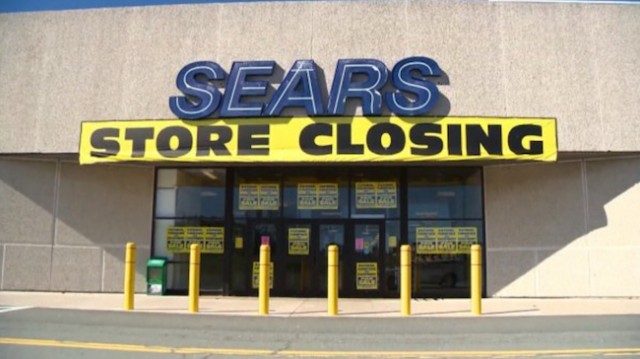
Sears filed for Chapter 11 bankruptcy protection Monday, buckling under its massive debt load and staggering losses.
The question now is whether a smaller version of the company that once dominated the American retail landscape can remain viable or whether the iconic brand will be forced out of business.
Sears, which started as a mail order catalogue in the 1880s, has been on a slow march toward extinction as it lagged far behind its peers and incurred massive losses over the years.
“This is a company that in the 1950s stood like a colossus over the American retail landscape,” said Craig Johnson, president of Customer Growth Partners, a retail consultancy. “Hopefully, a smaller new Sears will be healthier.”
The company has struggled with outdated stores and complaints about customer service. That’s in contrast with chains like Walmart, Target, Best Buy and Macy’s, which have been enjoying stronger sales as they benefit from a robust economy and efforts to make the shopping experience more inviting by investing heavily in remodeling and de-cluttering their stores.
Sears Holdings, which operates both Sears and Kmart stores, will close 142 unprofitable stores near the end of the year, with liquidation sales expected to begin shortly. That’s in addition to the closure of 46 unprofitable stores that had already been announced. Edward S. Lampert has stepped down as CEO but will remain chairman of the board. A new Office of the CEO will be responsible for managing day-to-day operations.
Sears joins a growing list of retailers that have filed for bankruptcy or liquidated in the last few years amid a fiercely competitive climate. Some, like Payless ShoeSource, successfully emerged from reorganization in bankruptcy court. But plenty of others like, Toys R Us and Bon-Ton Stores Inc., haven’t. Both retailers were forced to shutter their operations this year soon after Chapter 11 filings.
Given its sheer size, Sears’ bankruptcy filing will have wide ripple effects on everything from already ailing landlords to its tens of thousands of workers.
Lampert, the largest shareholder, has been loaning out his own money for years and has put together deals to prop up the company, which in turn has benefited his own ESL hedge fund.
Last year, Sears sold its famous Craftsman brand to Stanley Black & Decker Inc., following earlier moves to spin off pieces of its Sears Hometown and Outlet division and Lands’ End.
In recent weeks, Lampert has been pushing for a debt restructuring and offering to buy some of Sears’ key assets, like Kenmore, through his hedge fund as a $134 million debt repayment came due on Monday. Lampert personally owns 31 per cent of the company’s shares, while his hedge fund has an 18.5 per cent stake, according to FactSet.
“It is all well and good to undertake financial engineering, but the company is in the business of retailing and without a clear retail plan, the firm simply has no reason to exist,” said Neil Saunders, managing director of GlobalData Retail, in a recent analyst note.
Sears’ stock has fallen from about $6 over the past year to below the minimum $1 level that Nasdaq stocks are required to trade in order to remain on the stock index. In April 2007, shares were trading at around $141. The company, which once had 350,000 workers, has seen its workforce shrink to fewer than 90,000 people as of earlier this year.
As of May, it had fewer than 900 stores, down from a 2012 peak of 4,000.
In a March 2017 government filing, Sears said there was “substantial doubt” it would be able to keep its doors open — but insisted its turnaround efforts would mitigate that risk.
Lampert pledged to return Sears to greatness by leveraging its best-known brands and its vast holdings of land, and more recently planned to entice customers with a loyalty program. But losses continued and the company struggled to get more people through the doors or to shop online.
Jennifer Roberts, 36, of Dayton, Ohio, was a long-time fan of Sears and has fond memories of shopping there for clothes as a child. But in recent years, she’s been disappointed by the lack of customer service and outdated stores.
“My mom had always bought her appliances from Sears. That’s where my dad got his tools,” she said. “But they don’t care about their customers anymore.”
She said a refrigerator her mother bought at Sears broke after two years and still hasn’t been fixed.
“If they don’t value a customer, then they don’t need my money,” Roberts said.
Sales at the company’s established locations tumbled nearly 4 per cent during its fiscal second quarter. Still, that was an improvement from the same period a year ago. Total revenue dropped 30 per cent in the most recent quarter, hurt by continued store closings.
“The problem in Sears’ case is that it is a poor retailer,” Saunders wrote in his analyst note. “Put bluntly, it has failed on every facet of retailing from assortment to service to merchandise to basic shop keeping standards. Under benign conditions, this would be problematic enough but in today’s hyper-competitive retail environment it is a recipe for failure on a grand scale.”
For decades, Sears was king of the American shopping landscape. Sears, Roebuck and Co.’s iconic catalogue featured items from bicycles to sewing machines to houses, and could generate excitement throughout a household when it arrived. The company began opening retail locations in 1925 and expanded swiftly in suburban malls from the 1950s to 1970s. But the onset of discounters like Walmart created challenges for Sears that have only grown. Sears faced even more competition from online sellers and appliance retailers like Lowe’s and Home Depot.


